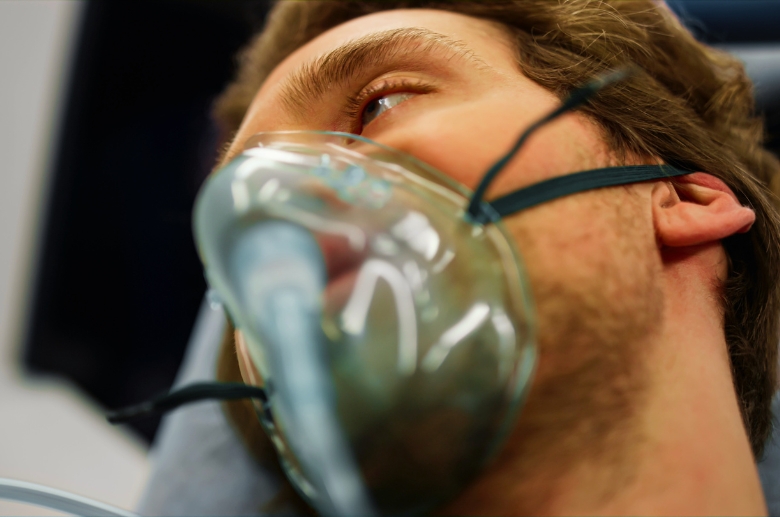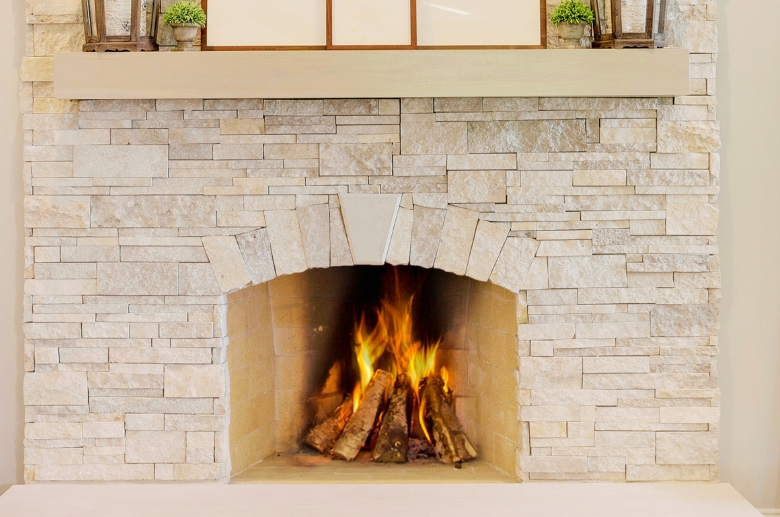Often called “the silent killer,” carbon monoxide (CO) is a colorless, odorless gas that can be lethal when inhaled. Among the common sources of CO in households, fireplaces stand out as especially dangerous culprits.

Fireplaces and other fuel-burning appliances can release carbon monoxide into your home if not properly maintained or if there are ventilation issues. This is where evaluating chimney safety becomes critical. Regular assessments of your chimney’s condition and proper maintenance play a pivotal role in preventing CO build-up and ensuring the safe operation of your fireplace.
That’s why this guide looks at how to check your fireplace for carbon monoxide, the importance of a carbon monoxide alarm, the potential dangers the gas poses, and how to ensure the safety of your home by regularly assessing your fireplace for this deadly gas.
——
Do You Need to Hire Chimney & Fireplace Expert?
Get free quotes from qualified experts near you. No commitment required!
——
Causes of Carbon Monoxide in Fireplaces
Carbon monoxide in fireplaces can be a hidden danger stemming from various factors. Some of these factors include:
- Incomplete combustion of fuel: When the fireplace doesn’t burn fuel (usually wood or gas) efficiently, carbon monoxide is produced as a byproduct.
- Blockage in the chimney or flue: Obstructions like soot, debris, or bird nests can block the chimney or flue, preventing proper ventilation. This blockage hinders the escape of combustion gases into the outside air, potentially leading to its buildup indoors.
- Damper issues: A malfunctioning or improperly adjusted damper can affect the airflow and combustion within the fireplace. If the damper doesn’t open or close correctly, it may result in incomplete combustion and increased carbon monoxide emissions.
- Damaged or malfunctioning parts: Faulty components like the firebox, burner, or flue can disrupt the fireplace’s operation, leading to incomplete combustion and carbon monoxide production.
- Poor ventilation: Inadequate ventilation in the room containing the fireplace can trap carbon monoxide indoors.
How to Check Your Fireplace for Carbon Monoxide
Ensuring the safety of your home is paramount, and knowing how to check your fireplace for carbon monoxide is a crucial step in maintaining a healthy living environment. In addition to carbon monoxide checks, it’s important to be aware of the risks of unused fireplaces, especially if you’re considering reactivating a fireplace that hasn’t been used in years.
Below are some of the steps for how to do this.
1. Install a Carbon Monoxide Detector Near the Fireplace
To ensure the safety of your home and loved ones, install a carbon monoxide detector near your fireplace. When installing a CO detector near your fireplace, consider the following factors:
Types of CO Detectors
Carbon monoxide detectors come in various types, including battery-operated, plug-in, and Smart detectors with mobile alerts. Battery-operated detectors are easy to install and maintain, while plug-in detectors are more reliable but require a nearby electrical outlet. Smart detectors provide real-time alerts on your mobile device, enhancing convenience and safety.
Ideal Placement in the House
Place CO detectors on every level of your home to ensure comprehensive coverage. Position them near sleeping areas and the room with a fireplace, as people spend a significant amount of time in these areas.
Testing and Maintenance
Test your CO detectors monthly to verify their functionality and replace their batteries annually. Follow the manufacturer’s recommendations for replacing the entire unit, typically every 5-7 years, to ensure accurate and reliable CO detection.
Regular Maintenance
Regular maintenance is key to the effectiveness of your CO detectors, so monitor them diligently to protect your home and family from the dangers of carbon monoxide.
2. Check the Flue and Chimney for Blockages
When inspecting your fireplace for carbon monoxide, examine the flue and chimney for potential blockages. This can be done through a visual inspection and an airflow test.
Start by visually inspecting the chimney and flue. Look for obvious obstructions, such as bird nests, leaves, or debris clogging the passage for smoke and gases to escape. Clearing these obstructions will ensure proper ventilation and prevent the buildup of carbon monoxide.
You can also conduct an airflow test using a smoke match or an incense stick. Light the match or incense and hold it near the fireplace opening. Observe whether the smoke is drawn up the chimney steadily or if it lingers around.
If the smoke lingers, it could indicate a blockage in the chimney, which needs to be addressed promptly.
To prevent future blockages, keep the area around the chimney clear of overhanging trees or plants that might drop debris. Additionally, consider installing a chimney cap to keep animals and debris from entering the chimney, reducing the risk of blockages and ensuring proper ventilation.
3. Inspect the Fireplace and Chimney for Cracks and Damage

Here are the key steps to follow when inspecting your fireplace and chimney for cracks and damage.
First, examine the exterior of the chimney for visible cracks or wear. Cracks in the chimney can let carbon monoxide gas seep into your home. Look for any signs of crumbling or discolored mortar. If you spot any issues, address them promptly.
Next, inspect the interior lining of the chimney for signs of deterioration or damage. The chimney liner is a crucial barrier that protects your home from CO and other harmful combustion byproducts. Any cracks, holes, or missing sections are warning signs and should be fixed immediately.
Evaluate the fireplace’s structure, ensuring the bricks and mortar are intact. Damaged masonry can compromise the integrity of your fireplace, potentially allowing CO to escape into your living space.
Over time, small issues can escalate into major structural problems that are both costly and hazardous. For major damage, seek professional advice and assistance from a certified chimney sweep or mason to ensure proper repairs.
Additionally, regular inspections help ensure that the chimney is cleaned of soot, creosote, and other buildup. Cleaning your chimney at least once a year is critical in CO prevention.
4. Schedule Annual Professional Chimney Inspections and Cleanings
To check your fireplace for carbon monoxide and ensure safe operation, schedule an annual professional chimney inspection and cleaning. Chimney inspections by certified technicians can identify potential issues in chimneys, such as blockages, creosote buildup, or structural damage that may lead to carbon monoxide leaks.
Regular chimney sweeps help remove flammable deposits and maintain proper airflow. Additionally, always open a window or door when using the fireplace to enhance ventilation and reduce carbon monoxide risks.
This simple measure promotes better air circulation and minimizes the chances of harmful gas buildup, keeping your home safe and warm during the colder months.
——
Do You Need to Hire Chimney & Fireplace Expert?
Get free quotes from qualified experts near you. No commitment required!
——
What to Do in Case of CO Poisoning
If you’re ever exposed to carbon monoxide, you should do the following immediately!
Get Fresh Air

In case of CO poisoning, the first step is to move to an area with fresh air. Open windows and doors to ventilate the space. Get out of the affected building to ensure you breathe clean air, as carbon monoxide is odorless and colorless.
Inadequate delivery of oxygen to the brain caused by inhaling carbon monoxide can result in symptoms such as fatigue, headaches, shortness of breath, confusion, and dizziness.
Turn Off All Appliances and Fireplaces
To prevent further CO exposure, turn off all gas appliances and fireplaces in the affected area. This includes wood stoves, furnaces, water heaters, and any other potential sources of carbon monoxide. Keep any heating appliance off until it’s safe to turn it back on.
Seek Medical Attention
Carbon monoxide poisoning can be life-threatening. If you suspect CO exposure or experience symptoms like headache, dizziness, nausea, confusion, or weakness, seek immediate medical attention. Call 911 or go to the nearest hospital. Medical professionals can perform tests and provide the necessary treatment.
Tips for Preventing Carbon Monoxide in Fireplaces
Here are essential tips to guarantee the safety of your chimney and fireplace, protecting your home from the risks of CO poisoning.
1. Use Only Dry and Seasoned Firewood
Use only dry and seasoned firewood to prevent carbon monoxide (CO) in fireplaces. Wet or green wood produces more smoke and lowers combustion efficiency, increasing CO emissions. Dry firewood burns cleaner, reducing the risk of CO buildup in your home.
2. Do Not Burn Trash or Other Materials in the Fireplace
Burning trash in your fireplace can release harmful chemicals, including CO, into your home. Stick to burning seasoned wood and avoid using the fireplace to dispose of items like plastics, cardboard, or treated wood, which can produce toxic fumes.
3. Install a Screen or Glass Doors to Prevent Sparks and Embers from Escaping
Installing a screen or glass doors in front of your fireplace can prevent sparks and embers from escaping and potentially igniting flammable materials in your home. This additional safety measure also helps contain the fire and reduces the risk of CO leakage.
4. Keep Flammable Materials Away from the Fireplace

To prevent CO in fireplaces, ensure no flammable materials are placed near the fireplace. Keep furniture, curtains, paper, and other combustibles safe from the fireplace to minimize the risk of fire and CO exposure.
5. Do Not Use Unvented Gas Fireplaces
Unvented gas fireplaces can produce CO if improper maintenance or malfunctions exist. To avoid CO exposure, opt for vented gas fireplaces that safely expel combustion byproducts outside your home, minimizing the risk of carbon monoxide buildup indoors. Regular maintenance is crucial for gas fireplace safety.
Conclusion
Now you know how to check your fireplace for carbon monoxide. Your diligence in maintaining a safe chimney is essential for safeguarding your well-being and that of your loved ones. Take the steps outlined here to ensure your fireplace is secure and free from potential carbon monoxide risks.
If you require help, contact us today for a professional assessment of potential carbon monoxide exposure. We’re here to assist you in navigating the process efficiently and effectively.






